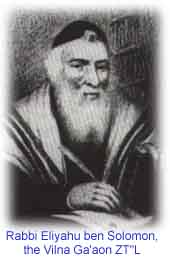|
|

|
|
|

|
The Ga'aon's 'Zionism'
RABBI ELIYAHU BEN-SHLOMO ZALMAN (1720-1797), better known as the "Ga'aon (Talmudic genius) of Vilna," was one of the greatest religious thinkers, researchers and writers of Jewish holy texts. Not so well known, however, is the extent to which
he was one of the forerunners of modern Zionism.
Born in the province of Grodno, the Ga'aon came from a
renowned rabbinical and scholarly family. He showed unusual aptitude from
childhood. Recognized early in life as an illui (child prodigy), at the
early age of six, he gave a complicated sermon (drasha) in the Synagogue of Vilna
amazing the listeners by answering questions with great depth. This, in a city known worldwide for its scholarship.
Until the age of 13, he studied mainly on his own, learning Oral and
Written Law as well as Kabbalah -- in spite of the fact that Kabbalah
is not usually tackled before the age of 40. Intensive study and seclusion
from the outside world continued after marriage at the age of 18.
At the age of 20, the Ga'aon moved from Vilna and spent eight years in
Jewish communities in Poland and Germany. He then returned to Vilna, where
he spent the rest of his life. A special house of study was built for him
where he spent his days, but he refused any public office, and devoted
himself to scholarship.
The Ga'aon's scholarly expertise covered not only the Babylonian Talmud but
also the Jerusalem Talmud, which was exceptional at that period. Additionally he studied general sciences including mathematics, history and music which he believed were essential to a proper understanding of Torah.
His approach was precise, intellectual, and totally dedicated --- he was said
to sleep only two hours each night, and to forbid any conversation not
devoted to the Torah. His teaching was logical and straightforward, as
opposed to the pilpul (deep annalysis) that characterized much
contemporary Talmud study. At the age of 40, he started lecturing to a group
of disciples, who disseminated his teachings throughout the rabbinical
academies of Lithuania.
The Ga'aon firmly believed that movement to the Holy Land was not to await the
Messianic era but to bring it about. As did a number of his Chasidic contemporaries, he himself set out for Eretz Israel in 1783, but for unknown reasons he did not attain his goal. However in a far reaching move, he inspired his disciples to do so.
They left from the cities of Shklov and Vilna in 1805, 1811 and 1813,
travelling via Turkey by horse and wagon. The trip was made all the more
dangerous by the Napoleonic Wars taking place at that time. Among them were
members of the well-known Rivlin, Zeitlin and Bassan families who have
since lived in Israel for many generations.
For a series of reasons, especially the impact of the failed attempt of a
group led by Rabbi Yehuda Hachasid to settle in Jerusalem over a century
earlier, there was no Ashkenazic presence in Jerusalem at this time. Any
Ashkenazi Jew who attempted to settle there was charged with the need to
pay to local Arabs the debts (and a century of accumulated interest) left
by that earlier failed settlement attempt.
Particularly significant were those arising from the acquisition for a
synagogue of the chatzer (courtyard) which had some five centuries earlier
been the site of a synagogue erected by the Ramban (Rabbi Moshe ben
Nachman) after the Crusader departure from Jerusalem. Accordingly, despite
the existence in Jerusalem of a small Sefardi community, most of the new
immigrants of the early 1800's made their homes in Safed (contemporary
Chassidic immigrants settled in Tiberias and Hebron).
Under the leadership of Reb Menachem Mendel of Shklov, attempts to resolve
the Jerusalem debt problem thereby facilitating establishment of an
Ashkenazi Yishuv (settlement) there, commenced in the 1820's. But success in achieving a firman (legal document) anulling the century old debt and granting Jews
clear title over the chatzer had to await the advent of the Egyptian-based
regime of Muhammed Ali who ruled over Eretz Israel from 1832 to 1840.
During the earthquake which struck the Galil in 1837, over 4000 Jews
perished. Believing that the catastrophe was a direct product of the
neglect of Jerusalem, the surviving disciples of the Ga'aon now moved from
Safed to Jerusalem, where they rebuilt the Churva synagogue, seeing it as
the forerunner of the final redemption. But contrary to the popular
stereotype of the Old Yishuv as being solely interested in learning Torah
and dying in the Holy City, they did not limit their activities to such
obviously religious pursuits.
In the interests of strengthening the Yishuv and its economic base they
corresponded with Moses Montefiore regarding establishment of agricultural
settlement in the vicinity of Jerusalem. They also sought from the Pasha
and achieved establishment of the first formal postal system connecting
Jerusalem with the outside world (via Egypt).
Even such activities were seen as having messianic overtones facilitating
the final redemptiion. In subsequent decades, they were instrumental in
the initial expansion of Jewish settlement beyond the city walls; Nachalat
Shiva, now in the centre of town, was the first such new area of
settlement.
The Ga'aon's students have not received due recognition of their role as
effectively as the pioneers of modern settlement in Israel -- a deficiency
currently being reversed by the display at Beth Hatefutzot -- the Tel Aviv
Museum of the Diaspora -- and Arie Morgenstern's comprehensive research
published by Yad Yitzchak Ben Zvi in honor of the bicentennial of the Gaon:
Geulah Bederech Hateva: Talmidei HaGra Be'Eretz Israel
Every weekday JewishWorldReview.com publishes inspiring articles. Sign up for our daily update. It's free. Just click here.

Though many may choose to ignore it -- or simply are unaware -- contemporary settlement in Israel was in large part inspired by an "ultra-Orthodox" rabbi in Vilna, Lithuania in the 1700s, writes Yossi Aron.